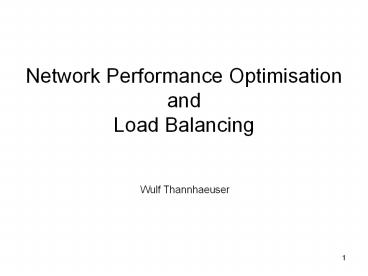Network Performance Optimisation and Load Balancing - PowerPoint PPT Presentation
Title:
Network Performance Optimisation and Load Balancing
Description:
Front End Links. Trigger Level 2 & 3. Event Filter. SFC. SFC. CPU. CPU. CPU. CPU ... a simple point-to-point connection with a crossed twisted pair or optical cable. ... – PowerPoint PPT presentation
Number of Views:21
Avg rating:3.0/5.0
Title: Network Performance Optimisation and Load Balancing
1
Network Performance OptimisationandLoad
Balancing
- Wulf Thannhaeuser
2
Network Performance Optimisation
3
Network Optimisation Where?
LHC-B Detector
Data rates
VDET TRACK ECAL HCAL MUON RICH
40 MHz
Level 0 Trigger
40 TB/s
Front-End Electronics
1 MHz
Timing Fast Control
L0
Fixed latency 4.0 ms
1 TB/s
L1
40 kHz
Level 1 Trigger
Front-End Multiplexers (FEM)
LAN
1 MHz
Front End Links
Variable latency lt1 ms
4 GB/s
RU
RU
RU
Read-out units (RU)
Throttle
Read-out Network (RN)
2-4 GB/s
Trigger Level 2 3 Event Filter
SFC
SFC
Sub-Farm Controllers (SFC)
Control Monitoring
Storage
20 MB/s
CPU
CPU
CPU
CPU
4
Network Optimisation Why?
Gigabit Ethernet
(Fast) Ethernet
- Ethernet Speed 10 Mb/s
- Fast Ethernet Speed 100 Mb/s
Gigabit Ethernet Speed 1000 Mb/s (considering
full-duplex 2000 Mb/s)
5
Network Optimisation Why?
6
Network Optimisation How?
- An average CPU
- might not be able to
- process such a huge
- amount of data packets
- per second
- TCP/IP Overhead
- Context Switching
- Packet Checksums
An average PCI Bus is 33 MHz, 32-bit
wide. Theory 1056 Mbit/s Actually ca. 850
Mbit/s (PCI overhead, burstsize)
7
TCP / UDP Comparison
- TCP (Transfer Control Protocol)
- - connection-oriented protocol
- - full-duplex
- - messages received in order, no loss or
duplication - ? reliable but with overheads
- UDP (User Datagram Protocol)
- - messages called datagrams
- - messages may be lost or duplicated
- - messages may be received out of order
- ? unreliable but potentially faster
8
Network Optimisation How?
- An average CPU
- might not be able to
- process such a huge
- amount of data packets
- per second
- TCP/IP Overhead
- Context Switching
- Packet Checksums
Reduce per packet Overhead Replace TCP with UDP
An average PCI Bus is 33 MHz, 32-bit
wide. Theory 1056 Mbit/s Actually ca. 850
Mbit/s (PCI overhead, burstsize)
9
Jumbo Frames
- Normal Ethernet
- Maximum Transmission Unit (MTU) 1500 bytes
10
Test set-up
- Netperf is a benchmark for measuring network
performance - The systems tested were 800 and 1800 MHz Pentium
PCs using (optical as well as copper) Gbit
Ethernet NICs. - The network set-up was always a simple
point-to-point connection with a crossed twisted
pair or optical cable. - Results were not always symmetric
- With two PCs of different performance, the
benchmark results were usually better if data was
sent from the slow PC to the fast PC, i.e. the
receiving process is more expensive.
11
Results with the optimisations so far
12
Network Optimisation How?
- An average CPU
- might not be able to
- process such a huge
- amount of data packets
- per second
- TCP/IP Overhead
- Context Switching
- Packet Checksums
Reduce per packet Overhead Replace TCP with UDP
Reduce number of packets Jumbo Frames
An average PCI Bus is 33 MHz, 32-bit
wide. Theory 1056 Mbit/s Actually ca. 850
Mbit/s (PCI overhead, burstsize)
13
Interrupt Coalescence
- Packet Processing without Interrupt coalescence
CPU
Memory
NIC
14
Interrupt Coalescence Results
15
Network Optimisation How?
- An average CPU
- might not be able to
- process such a huge
- amount of data packets
- per second
- TCP /IP Overhead
- Context Switching
- Packet Checksums
Reduce per packet Overhead Replace TCP with UDP
Reduce number of packets Jumbo Frames
An average PCI Bus is 33 MHz, 32-bit
wide. Theory 1056 Mbit/s Actually ca. 850
Mbit/s (PCI overhead, burstsize)
16
Checksum Offloading
- A checksum is a number calculated from the data
transmitted and attached to the tail of each
TCP/IP packet. - Usually the CPU has to recalculate the checksum
for each received TCP/IP packet in order to
compare it with the checksum in the tail of the
packet to detect transmission errors. - With checksum offloading, the NIC performs this
task. Therefore the CPU does not have to
calculate the checksum and can perform other
operations in the meanwhile.
17
Network Optimisation How?
- An average CPU
- might not be able to
- process such a huge
- amount of data packets
- per second
- TCP/IP Overhead
- Context Switching
- Packet Checksums
Reduce per packet Overhead Replace TCP with UDP
Reduce number of packets Jumbo Frames
An average PCI Bus is 33 MHz, 32-bit
wide. Theory 1056 Mbit/s Actually ca. 850
Mbit/s (PCI overhead, burstsize)
Or buy a faster PC with a better PCI bus ?
18
Load Balancing
19
Load Balancing Where?
LHC-B Detector
Data rates
VDET TRACK ECAL HCAL MUON RICH
40 MHz
Level 0 Trigger
40 TB/s
Front-End Electronics
1 MHz
Timing Fast Control
L0
Fixed latency 4.0 ms
1 TB/s
L1
40 kHz
Level 1 Trigger
Front-End Multiplexers (FEM)
LAN
1 MHz
Front End Links
Variable latency lt1 ms
4 GB/s
RU
RU
RU
Read-out units (RU)
Throttle
Read-out Network (RN)
2-4 GB/s
Trigger Level 2 3 Event Filter
SFC
SFC
Sub-Farm Controllers (SFC)
60 SFCs with ca. 16 off the shelf PCs each
Control Monitoring
Storage
20 MB/s
CPU
CPU
CPU
CPU
20
Load Balancing with round-robin
Problem The SFC doesnt know if the node it
wants to send the event to is ready to process
it yet.
21
Load Balancing with control-tokens
2
1
3
1
With control tokens, nodes who are ready send a
token, and every event is forwarded to the sender
of a token.
22
LHC Comp. Grid Testbed Structure
SFC































